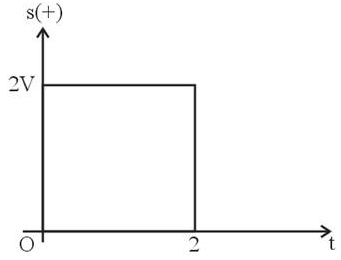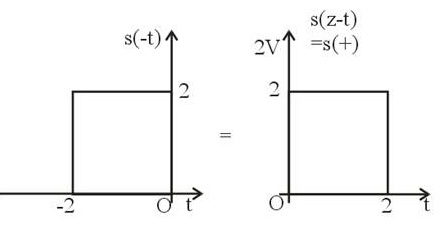GATE Exam > GATE Questions > Consider the signal s(t) shown in the figure,...
Start Learning for Free
Consider the signal s(t) shown in the figure, which is the output of an AWGN (Additive White Gaussian Noise) channel with two-sided noise PSD (Power Spectral Density) of 0.5W/Hz. If the signal is given as an input to a matched filter to s(t), then the slope of the output signal for 2V.

- a)4,6
- b)-4,6
- c)4,12
- d)-4,12
Correct answer is option 'D'. Can you explain this answer?
| FREE This question is part of | Download PDF Attempt this Test |
Verified Answer
Consider the signal s(t) shown in the figure, which is the output of a...
Matched filter impulse, h(t) = s*(2 - t) = s(2 - t) = s(t) [from the figure]


Slope (for \(2We have, Noise PSD (two-sided) = N0/2 = 1/2 W/Hz And bit energy or energy of signal s(t), Eb = 22 x 2 = 8Vs
Maximum output SNR 

SNRs = 10 log10 16 = 12.04dB ≈ 12dB

|
Explore Courses for GATE exam
|

|
Similar GATE Doubts
Consider the signal s(t) shown in the figure, which is the output of an AWGN (Additive White Gaussian Noise) channel with two-sided noise PSD (Power Spectral Density) of 0.5W/Hz. If the signal is given as an input to a matched filter to s(t), then the slope of the output signal for 2V.a)4,6b)-4,6c)4,12d)-4,12Correct answer is option 'D'. Can you explain this answer?
Question Description
Consider the signal s(t) shown in the figure, which is the output of an AWGN (Additive White Gaussian Noise) channel with two-sided noise PSD (Power Spectral Density) of 0.5W/Hz. If the signal is given as an input to a matched filter to s(t), then the slope of the output signal for 2V.a)4,6b)-4,6c)4,12d)-4,12Correct answer is option 'D'. Can you explain this answer? for GATE 2024 is part of GATE preparation. The Question and answers have been prepared according to the GATE exam syllabus. Information about Consider the signal s(t) shown in the figure, which is the output of an AWGN (Additive White Gaussian Noise) channel with two-sided noise PSD (Power Spectral Density) of 0.5W/Hz. If the signal is given as an input to a matched filter to s(t), then the slope of the output signal for 2V.a)4,6b)-4,6c)4,12d)-4,12Correct answer is option 'D'. Can you explain this answer? covers all topics & solutions for GATE 2024 Exam. Find important definitions, questions, meanings, examples, exercises and tests below for Consider the signal s(t) shown in the figure, which is the output of an AWGN (Additive White Gaussian Noise) channel with two-sided noise PSD (Power Spectral Density) of 0.5W/Hz. If the signal is given as an input to a matched filter to s(t), then the slope of the output signal for 2V.a)4,6b)-4,6c)4,12d)-4,12Correct answer is option 'D'. Can you explain this answer?.
Consider the signal s(t) shown in the figure, which is the output of an AWGN (Additive White Gaussian Noise) channel with two-sided noise PSD (Power Spectral Density) of 0.5W/Hz. If the signal is given as an input to a matched filter to s(t), then the slope of the output signal for 2V.a)4,6b)-4,6c)4,12d)-4,12Correct answer is option 'D'. Can you explain this answer? for GATE 2024 is part of GATE preparation. The Question and answers have been prepared according to the GATE exam syllabus. Information about Consider the signal s(t) shown in the figure, which is the output of an AWGN (Additive White Gaussian Noise) channel with two-sided noise PSD (Power Spectral Density) of 0.5W/Hz. If the signal is given as an input to a matched filter to s(t), then the slope of the output signal for 2V.a)4,6b)-4,6c)4,12d)-4,12Correct answer is option 'D'. Can you explain this answer? covers all topics & solutions for GATE 2024 Exam. Find important definitions, questions, meanings, examples, exercises and tests below for Consider the signal s(t) shown in the figure, which is the output of an AWGN (Additive White Gaussian Noise) channel with two-sided noise PSD (Power Spectral Density) of 0.5W/Hz. If the signal is given as an input to a matched filter to s(t), then the slope of the output signal for 2V.a)4,6b)-4,6c)4,12d)-4,12Correct answer is option 'D'. Can you explain this answer?.
Solutions for Consider the signal s(t) shown in the figure, which is the output of an AWGN (Additive White Gaussian Noise) channel with two-sided noise PSD (Power Spectral Density) of 0.5W/Hz. If the signal is given as an input to a matched filter to s(t), then the slope of the output signal for 2V.a)4,6b)-4,6c)4,12d)-4,12Correct answer is option 'D'. Can you explain this answer? in English & in Hindi are available as part of our courses for GATE.
Download more important topics, notes, lectures and mock test series for GATE Exam by signing up for free.
Here you can find the meaning of Consider the signal s(t) shown in the figure, which is the output of an AWGN (Additive White Gaussian Noise) channel with two-sided noise PSD (Power Spectral Density) of 0.5W/Hz. If the signal is given as an input to a matched filter to s(t), then the slope of the output signal for 2V.a)4,6b)-4,6c)4,12d)-4,12Correct answer is option 'D'. Can you explain this answer? defined & explained in the simplest way possible. Besides giving the explanation of
Consider the signal s(t) shown in the figure, which is the output of an AWGN (Additive White Gaussian Noise) channel with two-sided noise PSD (Power Spectral Density) of 0.5W/Hz. If the signal is given as an input to a matched filter to s(t), then the slope of the output signal for 2V.a)4,6b)-4,6c)4,12d)-4,12Correct answer is option 'D'. Can you explain this answer?, a detailed solution for Consider the signal s(t) shown in the figure, which is the output of an AWGN (Additive White Gaussian Noise) channel with two-sided noise PSD (Power Spectral Density) of 0.5W/Hz. If the signal is given as an input to a matched filter to s(t), then the slope of the output signal for 2V.a)4,6b)-4,6c)4,12d)-4,12Correct answer is option 'D'. Can you explain this answer? has been provided alongside types of Consider the signal s(t) shown in the figure, which is the output of an AWGN (Additive White Gaussian Noise) channel with two-sided noise PSD (Power Spectral Density) of 0.5W/Hz. If the signal is given as an input to a matched filter to s(t), then the slope of the output signal for 2V.a)4,6b)-4,6c)4,12d)-4,12Correct answer is option 'D'. Can you explain this answer? theory, EduRev gives you an
ample number of questions to practice Consider the signal s(t) shown in the figure, which is the output of an AWGN (Additive White Gaussian Noise) channel with two-sided noise PSD (Power Spectral Density) of 0.5W/Hz. If the signal is given as an input to a matched filter to s(t), then the slope of the output signal for 2V.a)4,6b)-4,6c)4,12d)-4,12Correct answer is option 'D'. Can you explain this answer? tests, examples and also practice GATE tests.

|
Explore Courses for GATE exam
|

|
Suggested Free Tests
Signup for Free!
Signup to see your scores go up within 7 days! Learn & Practice with 1000+ FREE Notes, Videos & Tests.


















